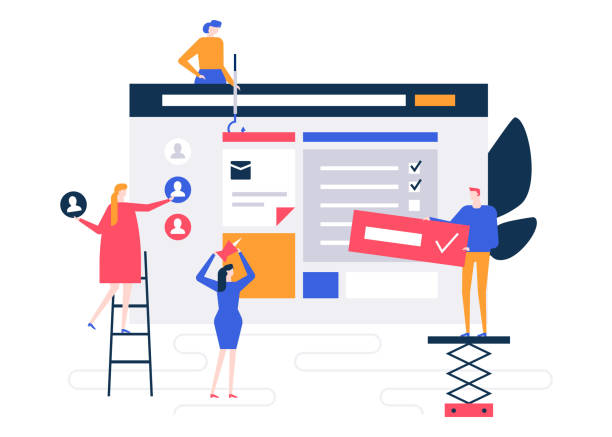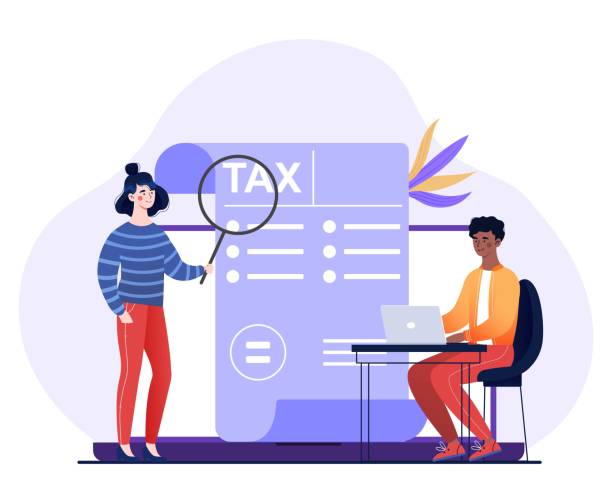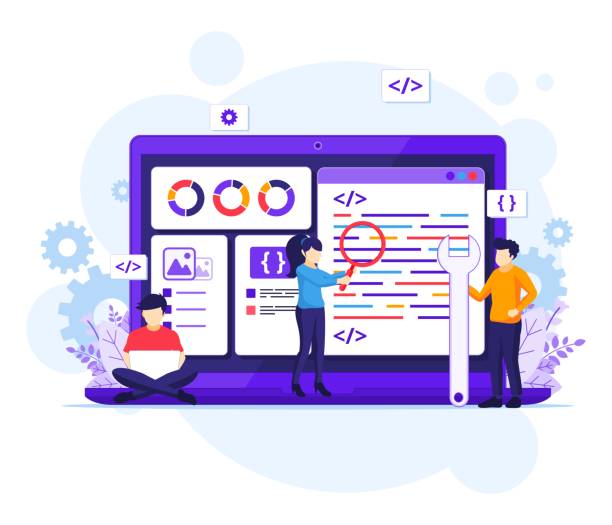Introduction to the Importance of Professional Website Design in Today’s World

In the current digital age, having a #professional website is no longer an option, but an unavoidable necessity for any business and individual seeking success and visibility.
A professional website design is not only your business’s storefront in the virtual world, but also a powerful tool for attracting new customers, enhancing credibility, and presenting your services and products to a global audience.
This process goes beyond merely arranging a few images and texts; it involves a deep understanding of user needs, aesthetic and technical principles to create an unparalleled experience.
Therefore, investing in professional website design can yield exceptional returns in the long run.
This section provides an overview of the general concepts.
To start any professional website design project, you must first define your goals.
Are you looking to sell products (e-commerce website), offer services (corporate website), or publish content (blog or news portal)? Each of these goals requires a specialized approach in design and development.
Furthermore, a precise understanding of your target audience helps you produce engaging content that encourages greater user interaction.
A poorly designed website not only destroys business opportunities but can also harm your brand’s credibility.
Therefore, attention to detail, adhering to SEO principles from the outset, and creating a secure and fast platform are considered fundamental pillars of a professional website design.
Subsequent sections of this article will provide a more comprehensive guide on each of these aspects.
Creating a professional website design is not just about a beautiful appearance, but also about functionality, efficiency, and accessibility for all users.
This includes optimization for various devices (responsiveness), high loading speed, and easy navigation.
Today, given the increased use of mobile phones, responsiveness is a crucial feature.
Users expect your website to display correctly on any device, from desktops to smartphones.
Failure to adhere to these principles can lead to loss of visitors and reduced conversion rates.
Therefore, a significant portion of the professional website design process is dedicated to these aspects to ensure an optimal user experience, encouraging users to stay on your site longer and achieve your desired goals.
Tired of losing business opportunities due to not having a professional corporate website?
Rasaweb helps you with professional corporate website design to:
✅ Build a powerful and reliable image for your brand
✅ Convert website visitors into loyal customers
⚡ Get a free consultation now!
Principles and Fundamentals of Successful Website Design and its Impact on User Experience

A professional website design is built upon a set of principles and fundamentals, adherence to which is essential for achieving success.
These principles extend beyond mere visual aesthetics and encompass technical, psychological, and communicative aspects.
The first principle is simplicity and ease of use.
Users should be able to navigate your website easily and find the information they need.
Excessive complexity in design or navigation can lead to user confusion and quick exit.
The second principle is consistency in design and visual identity.
Using consistent colors, fonts, and styles throughout the website helps create a cohesive experience and makes your brand memorable to users.
This consistency is one of the hallmarks of a professional website design.
The third principle is the importance of high-quality and engaging content.
Your content should not only be informative and relevant but also presented in a way that encourages users to read and interact more.
Using high-quality images and videos, infographics, and well-organized texts with short paragraphs and engaging headings can significantly improve the user experience.
Also, a clear and specific Call to Action (CTA) encourages users to perform actions such as purchasing, signing up, or contacting.
This is a key element in professional website design to achieve your business goals.
Your website should be a clear guide for users.
The fourth principle is optimization for speed and performance.
Nothing is more annoying to a user than a slow website.
High loading speed not only improves user experience but is also a crucial factor in SEO ranking.
Using optimized images, clean coding, and minimizing unnecessary scripts can help improve website speed.
Finally, the responsiveness of the website for correct display on all devices, from desktop computers to smartphones and tablets, is of paramount importance.
This feature ensures that your website is accessible and usable for every user, regardless of the device used, and this is a sign of a professional website design.
This is an analytical aspect of your website’s performance.
Choosing the Right Platform for Professional Website Design

Choosing the right platform is one of the most crucial decisions in the professional website design process.
Various platforms exist, each with its own advantages and disadvantages, suitable for specific types of websites.
The correct choice can significantly impact costs, time, and the future flexibility of your website.
The three main categories of platforms are: Content Management Systems (CMS), Website Builders, and Custom Coding.
Each of these options can be used for a professional website design, but choosing the best one requires a careful assessment of your needs.
This educational section will help you make the best decision.
One of the most popular CMSs is WordPress, which due to its high flexibility, numerous plugins, and extensive user community, is highly suitable for professional website design across various types (from personal blogs to online stores and corporate websites).
WordPress is considered a specialized option for website development.
Website builders like Wix and Squarespace allow you to create websites without needing coding knowledge and are good options for small businesses and individuals looking for a quick launch.
These platforms usually come with ready-made templates and a drag-and-drop user interface that simplify the design process.
In contrast, custom coding (using languages like HTML, CSS, JavaScript, and PHP) offers maximum flexibility and customization, but requires high technical knowledge and higher costs.
This method is ideal for very complex and unique projects with specific needs.
For a professional website design with highly specific functionalities, custom coding is preferred.
To help you choose the right platform for your professional website design, the table below provides a comparison between the three main types of platforms.
This explanatory information will help you in your decision-making.
| Feature | Content Management System (CMS – e.g., WordPress) | Website Builders (e.g., Wix, Squarespace) | Custom Coding (HTML, CSS, JS, PHP) |
|---|---|---|---|
| Ease of Use | Medium to High (requires initial learning) | Very High (drag-and-drop interface) | Low (requires deep technical knowledge) |
| Flexibility and Customization | High (through plugins and templates) | Medium (limited by platform capabilities) | Very High (unlimited possibilities) |
| Cost | Medium (hosting, domain, theme/plugin) | Medium to High (monthly/annual subscription) | High (specialized labor, maintenance) |
| Scalability | High (expandable for large projects) | Medium (limitations in scalability) | Very High (designed for growth) |
| Maintenance Requirement | Medium (updating plugins and core) | Low (platform is responsible for maintenance) | High (requires a developer for updates and troubleshooting) |
By reviewing this table, you can make the best decision to start your professional website design project.
However, regardless of the platform choice, attention to the fundamental principles of professional website design, such as mobile optimization and loading speed, remains of high importance.
The Role of User Experience (UX) and User Interface (UI) in Professional Design

In the world of professional website design, two concepts, UX (User Experience) and UI (User Interface), play vital roles and are often mistaken for each other, while each covers different aspects of a website.
User Interface (UI) refers to the visual design of the website; it includes buttons, icons, fonts, colors, images, and all visual elements with which the user interacts.
The goal of UI is to create a beautiful and eye-catching website that attracts users.
In contrast, User Experience (UX) addresses the user’s overall feeling and experience when using the website.
This includes the ease of use, efficiency, enjoyment, and accessibility of the website.
A professional website design requires attention to both aspects to achieve long-term success.
For example, if a website has a beautiful UI design but users cannot easily access the information they need or the purchasing process is complicated, it will have a poor User Experience (UX).
This can lead to a high bounce rate and reduced conversion rates.
Conversely, a website with a strong UX design, even if its UI is very simple, can keep users satisfied and achieve its goals.
A professional website design must strike a balance between these two; a website that is both beautiful and functional.
To achieve this balance, various steps are included in the UX/UI design process, such as user research, wireframe design, prototype creation, and usability testing.
This section provides useful guidance for a deep understanding of these concepts.
User research helps in understanding the needs, behaviors, and expectations of the target audience.
This lays the foundation for creating a professional website design that truly meets user needs.
Wireframes are initial, simple layouts of the website’s structure that define the placement of elements and the user flow.
Prototypes are more interactive versions of wireframes that allow designers and clients to simulate the user experience before full coding.
Usability testing also involves observing real users interacting with the website to identify design strengths and weaknesses.
Feedback from these tests is invaluable for improving professional website design.
Finally, explanatory content and detailed guidance in each section of the website can also greatly help improve the user experience.
All these interconnected steps lead to a professional website design and efficient.
Tired of losing customers due to poor e-commerce website design? With Rasaweb, solve this problem forever!
✅ Increase sales and conversion rates from visitor to customer
✅ Smooth and engaging user experience for your customers⚡ Get a free consultation
Search Engine Optimization (SEO) in Web Design

Search Engine Optimization (SEO) is an integral part of a professional website design.
Without SEO, even the most beautiful and user-friendly websites might remain obscure among a multitude of other websites.
SEO is the process of improving your website’s ranking in organic search results of engines like Google, with the goal of increasing visibility and attracting more traffic.
This process should begin from the initial stages of professional website design and includes technical, content, and backlink aspects.
SEO is a complex and specialized process that requires knowledge and experience.
This section provides an overview of SEO in web design.
From a technical perspective, professional website design should be such that search engines can easily crawl and index it.
This includes proper URL structure, the use of XML sitemaps, robots.txt file, and high loading speed.
Also, website responsiveness (mobile-friendly) is now considered a very important ranking factor for Google.
In terms of content, producing high-quality, unique, and relevant content aligned with target keywords is of high importance.
Proper use of headings (H1, H2, H3), meta descriptions, and keywords in the text helps search engines better understand the main topic of your pages.
This analytical approach to content is crucial for SEO.
In addition to technical and content aspects, Link Building also plays a significant role in SEO.
Incoming links (backlinks) from other reputable websites are an indicator of your website’s credibility and importance to search engines.
However, it should be noted that the quality of links is more important than their quantity; spammy or irrelevant links can harm your SEO ranking.
Also, optimizing images with appropriate Alt tags, and enhancing the overall User Experience (UX) of the website indirectly impacts SEO, as Google gives more importance to websites that offer a good user experience.
By integrating these strategies from the very beginning of your professional website creation, you can significantly increase its chances of visibility and success in the online space.
This is a practical guide for SEO.
Website Security and Maintenance After Professional Design
![]()
After completing the professional website design process and launching it, another crucial stage begins: website security and maintenance.
A website, like any other software system, requires continuous care and attention to be protected against security threats and to function properly.
Neglecting security can lead to website hacking, loss of sensitive information, decline in SEO ranking, and loss of user trust.
Therefore, a significant part of the commitment to a professional website design is ensuring its long-term security and stability.
This news section addresses the importance of this topic.
One of the first security measures is the use of an SSL/TLS certificate, which encrypts traffic between the website and users.
This not only ensures data security but is also a ranking factor in Google.
Regular updates of the Content Management System (CMS), themes, and plugins are also highly important, as many security attacks occur through vulnerabilities in older software versions.
Using strong and unique passwords, and enabling Two-Factor Authentication (2FA) for administrative access, provides additional layers of security.
Also, regular backup of the website, in case of any problem or attack, allows for restoring the website to its previous state.
This specialized approach is vital for security.
In terms of maintenance, regular checking of broken links, database optimization, clearing website cache, and monitoring its performance through tools like Google Search Console and Google Analytics are essential.
These measures help identify and resolve potential issues before they escalate into larger problems.
Image and CSS/JavaScript code optimization should also be performed continuously to improve loading speed and user experience.
A professional website design is not a one-time project, but an ongoing process that, with proper care and maintenance, can add value to your business for years and ensure your strong online presence.
This is an important educational aspect for any website owner.
Measuring Success and Data Analysis in Professional Website Design

After the initial launch and maintenance of professional website design, the next stage is measuring success and data analysis.
Without specific data and metrics, it’s difficult to know whether the website has achieved its goals or not, and where improvements are needed.
Data analysis allows you to understand user behavior, identify the strengths and weaknesses of the website, and make data-driven decisions for continuous improvement.
This is considered an essential component of any professional website design and helps you to always stay on the path of progress.
This analytical section helps you measure your website’s performance.
Tools such as Google Analytics and Google Search Console provide valuable information about website traffic, visitor sources, keywords used, popular pages, Bounce Rate, average time on page, and conversion rate.
Website traffic indicates the number of visitors, while traffic sources (organic search, social media, referral links) help you measure the effectiveness of your marketing strategies.
Bounce rate indicates the percentage of visitors who leave the website after viewing only one page; a high bounce rate can indicate a poor user experience or a lack of content relevance to user expectations.
In a professional website design, the goal is to reduce bounce rate and increase user retention time.
Conversion Rate is one of the most important success metrics, showing how many visitors have performed your desired action (e.g., purchase, sign-up, or download).
Accurate analysis of these metrics helps you understand which parts of your professional website design are performing well and which parts need improvement.
For example, if the conversion rate on a particular product page is low, there might be a need to improve images, product descriptions, or the call to action.
This explanatory and analytical information is crucial for continuous website optimization.
An advanced website development requires continuous attention to these metrics.
| Metric | Description | Importance in Professional Website Design |
|---|---|---|
| Website Traffic (Pageviews / Sessions) | Total number of views or visitor sessions. | Indicates the level of visibility and overall attractiveness of the website. |
| Bounce Rate | Percentage of visitors who leave the website after viewing one page. | A high rate indicates weaknesses in UX, content, or loading speed. The goal is to reduce it. |
| Average Time on Page | The average amount of time visitors spend on a specific page. | An increase indicates the attractiveness and usefulness of the content for users. |
| Conversion Rate | Percentage of visitors who perform a target action (purchase, sign-up). | The most important metric for measuring website business success. Indicates design effectiveness. |
| New vs. Returning Visitors | Percentage of users who visit the website for the first time versus those who have previously visited. | A balanced ratio indicates attracting new users and retaining old ones. |
By continuously monitoring these metrics and conducting A/B tests, you can constantly improve your professional website design and optimize its performance.
This continuous process helps ensure your website remains a valuable asset for your business.
New Trends in Website Design and Their Impact

The world of professional website design is constantly changing and evolving.
New trends rapidly emerge and can deeply impact how users interact with websites and the success of a professional website design.
Awareness of these trends and integrating them into your design strategy can help your website stay fresh and attractive, and outperform competitors.
This news section addresses some of the most important current and future trends in this field.
This information is a guide for advanced website design.
One of the most important trends is Mobile-First Design.
Given the increasing use of smartphones to access the internet, designing websites first for mobile devices and then for desktops has become a standard.
This approach ensures an optimal user experience on smaller devices.
Another trend is the widespread use of animations and micro-interactions.
Subtle animations and small interactions can help improve user experience, guide users to specific actions, and create an entertaining and engaging website.
These elements not only enhance visual aesthetics but also breathe life into your website, differentiating it from other websites.
This specialized approach can help your professional website design.
Also, the increasing use of Artificial Intelligence (AI) and Machine Learning in web design is a significant trend.
These technologies can be used for personalizing user experience, providing relevant suggestions, chatbots, and optimizing content based on user behavior.
Voice User Interface (VUI) design is also growing with the increasing popularity of voice assistants like Siri and Alexa, allowing websites to be accessible via voice commands.
Minimalist design and the use of white space have also maintained their popularity, as they aid content readability and make the website appear cleaner and more professional.
By following these trends, you can ensure that your professional website design remains modern and efficient, providing the best experience for users.
These trends help in creating your specialized online presence.
Does your current website showcase your brand’s credibility as it should? Or does it drive away potential customers?
Rasaweb, with years of experience in professional corporate website design, is your comprehensive solution.
✅ A modern, beautiful website tailored to your brand identity
✅ Significant increase in lead generation and new customers
⚡ Contact Rasaweb now for a free consultation on corporate website design!
Common Mistakes in Website Design and Their Solutions

In the professional website design process, making common mistakes can have a significant negative impact on website performance and user experience.
Understanding these mistakes and knowing their solutions is essential for any designer or website owner.
This explanatory section examines the most common mistakes and practical solutions to overcome them, so you can avoid these in creating your specialized online presence.
One of the most common mistakes is neglecting responsiveness (mobile compatibility).
Given that a significant portion of internet traffic comes from mobile devices, a website that does not display well on smartphones practically loses half of its audience.
The solution to this problem is using Responsive Design, which builds the website to automatically adjust to the user’s screen size.
Another mistake is slow website loading speed.
Today’s users are impatient, and if your website takes more than a few seconds to load, they will likely leave it.
Optimizing images, compressing codes, using Content Delivery Networks (CDNs), and choosing suitable hosting are among the solutions for improving speed.
This specialized aspect is important for speed.
Complex and unintuitive navigation is also considered a big mistake.
Users should be able to navigate your website easily and access the information they need.
Clear menus, logical hierarchical structure, and the use of a Sitemap can help improve navigation.
Inappropriate or low-quality content is another common mistake.
Your content should be informative, engaging, and relevant to the needs of the target audience.
Investing in high-quality content creation is one of the best investments for a professional website design.
Neglecting SEO from the outset can also lead to losing visibility opportunities in search engines.
By observing these points and performing regular reviews, you can ensure a professional and efficient website design that is optimized for both users and search engines.
This is an entertaining yet informative guide to avoid these mistakes.
Future Outlook of Website Design and Innovations

The future of professional website design is full of exciting innovations and advancements that will make the user experience more personalized and interactive than ever.
With rapid technological advancements, web designers and developers must constantly be learning and adapting to changes to stay at the forefront of this industry.
This analytical and explanatory section addresses some of the anticipated trends and emerging technologies that will shape the future of advanced website development.
One of the main trends is the increased focus on interactive and 3D Design.
With improved browser capabilities and internet speed, the use of 3D graphics and Augmented Reality (AR) and Virtual Reality (VR) models in websites will increase.
These technologies can provide a much more immersive and entertaining experience for users, especially in areas such as e-commerce (e.g., for displaying products in the user’s real environment) and gaming.
This can significantly give your professional website design a modern flair.
Also, AI-Powered Design will play a more prominent role.
AI-powered tools can help designers automate repetitive tasks, generate initial designs, and personalize content based on user data.
Progressive Web Apps (PWAs) will also continue to grow.
PWAs are a combination of the best features of websites and mobile applications that can work offline, send push notifications, and offer a user experience similar to a native app.
This is crucial for a professional website design, as it allows your website to function beyond a browser.
The focus on Green and Sustainable Websites is also increasing.
Designers will increasingly seek ways to reduce websites’ energy and carbon consumption through optimized coding and choosing environmentally friendly hosting.
Finally, an increased emphasis on cybersecurity and data privacy will also become a critical aspect of professional website design with growing concerns about data breaches.
By embracing these innovations, we can look forward to a brighter and more efficient future for the web.
Frequently Asked Questions
| Row | Question | Answer |
|---|---|---|
| 1 | What is professional website design? | The process of creating a user-friendly, visually appealing, fast, secure, and search engine-optimized website that achieves business goals and connects with the audience. |
| 2 | Why is responsiveness important in professional design? | Responsiveness ensures that the website displays correctly on all devices (mobile, tablet, desktop) and provides a consistent user experience, which is also vital for SEO. |
| 3 | What is the role of UI/UX in professional website design? | UI (User Interface) focuses on the visual aesthetics and appearance of the website, and UX (User Experience) focuses on ease of use, simple navigation, and enjoyable user interaction with the website. Both are essential for attracting and retaining the audience. |
| 4 | How does website loading speed affect its professionalism? | High loading speed improves user experience, reduces bounce rate, and is an important factor in website ranking by search engines. |
| 5 | What is the importance of SEO in professional website design? | SEO helps the website appear in Google and other search engine results, attracts more organic traffic, and contributes to business growth. |
| 6 | What role does high-quality content play in a professional website? | Engaging, relevant, and useful content keeps users on the website longer, enhances brand credibility, and is also very important for SEO. |
| 7 | What does professional website security include? | Using an SSL certificate, regular updates of the platform and plugins, regular backups, using strong passwords, and protection against cyber attacks. |
| 8 | What platforms are common for professional website design? | Content Management Systems (CMS) like WordPress and Joomla, as well as coding frameworks like React, Angular, and Vue.js for custom development. |
| 9 | What are the main phases of professional website design? | Planning and research, UI/UX design, coding and development, testing and launch, and finally maintenance and support. |
| 10 | What is the main difference between a professional website and an amateur website? | A professional website is built with a focus on business goals, user experience, security, performance, and optimization, while an amateur website usually lacks these comprehensive and targeted approaches. |
And other advertising services from Rasaweb Advertising Agency
Smart Custom Software: A dedicated service for growth in sales based on Google Ads management.
Smart Link Building: A combination of creativity and technology to increase click-through rates through custom programming.
Smart Content Strategy: A new service for increasing online growth through precise audience targeting.
Smart Digital Branding: A new service for increasing campaign management through user experience customization.
Smart Social Media: Professional optimization to increase click-through rates using precise audience targeting.
And over hundreds of other services in the field of internet advertising, advertising consultation, and organizational solutions
Internet Advertising | Advertising Strategy | Advertorials
References
- Principles of Professional Website Design
- Responsive Website Design Guide
- Importance of UI and UX in Website Design
- SEO Tips for New Websites
? Are you ready for your business to leap forward in the digital world? Rasaweb Afarin, a leading digital marketing agency, with expertise in SEO, Google Ads, and fast website design, paves your path to online success.
📍 Tehran, Mirdamad Street, next to Bank Markazi, Kazeroon Jonubi Alley, Ramin Alley, No. 6


